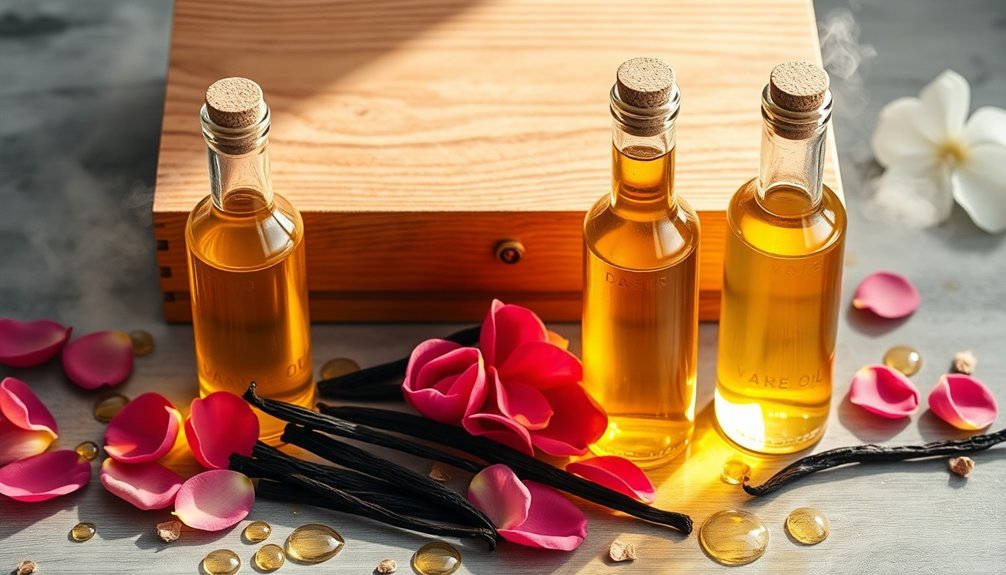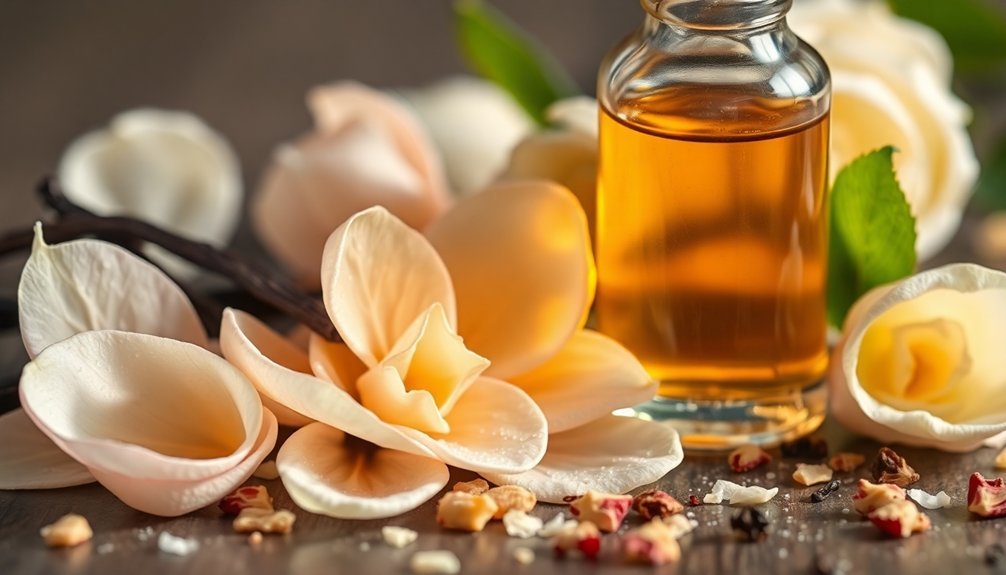Create your own luxurious vanilla-rose perfume oil by combining high-quality rose and vanilla essential oils with jojoba oil as a carrier. You'll want to start with a simple ratio of 15 drops rose oil, 10 drops vanilla oil, and 1 ounce of jojoba oil in a dark glass bottle. Store your blend away from sunlight and let it mature for several weeks, testing weekly for ideal scent development. This classic fragrance combination offers just the beginning of your journey into artisanal perfumery.
The Magic of Vanilla and Rose in Perfumery

Fragrance artistry takes on a divine form in the union of vanilla and rose, two of perfumery's most cherished ingredients.
You'll find these timeless essences deeply rooted in history, from ancient Egyptian ceremonies to modern luxury perfumes. When combined, they create a powerful sensory experience that's both sophisticated and emotionally resonant.
In perfumery, rose acts as a middle note, offering its classic floral heart, while vanilla provides a warm, sensual base that anchors the blend. The addition of chamomile's earthy touch creates an even more balanced and soothing aroma.
You're experiencing centuries of tradition when you smell this combination – rose's association with love and romance perfectly complements vanilla's comforting warmth.
Together, they'll transport you through a complex aromatic journey that evolves on your skin, delivering both the immediate allure of rose and the lasting embrace of vanilla.
Essential Ingredients for Your Vanilla-Rose Blend
For your vanilla-rose blend, you'll want to start with high-quality essential oils, as they form the foundation of your fragrance.
Your starter kit needs just four key ingredients: pure vanilla and rose essential oils, a carrier oil like jojoba, and dark glass bottles for storage.
When selecting your oils, look for organic, undiluted versions from reputable suppliers to guarantee the best possible scent outcome. The oils must be carefully combined, as order of mixing oils is crucial – starting with base notes like vanilla before adding the rose.
Quality Matters Most
The heart of any exceptional vanilla-rose blend lies in selecting premium ingredients.
You'll want to source high-quality organic rose essential oil for its deep floral notes and emotional depth, paired with pure vanilla essential oil for its warm, comforting qualities.
When choosing your carrier oil, opt for jojoba oil, as it won't interfere with your fragrance while providing nourishing benefits to your skin. Since daily smell tests help monitor the development of your blend, consider making a small test batch first.
If you're looking for an alternative, refined coconut oil works well due to its neutral scent profile.
Don't compromise on quality – organic essential oils guarantee you're getting pure, natural fragrances without synthetic additives.
Remember, your perfume's success depends largely on the purity of its components.
Even small amounts of premium oils will yield better results than larger quantities of lower-quality ingredients.
Simple Starter Kit
Creating your vanilla-rose blend starts with gathering a core set of essential ingredients.
You'll need rose and vanilla essential oils for the primary fragrance, along with chamomile oil to add a soothing touch.
For your carrier base, jojoba oil works perfectly due to its smooth, non-greasy texture and moisturizing properties.
Start with a 15-25% concentration of essential oils mixed with 75-85% jojoba oil for a balanced blend.
You'll also need a glass or crystal vial to store your creation, as these materials won't react with the oils.
While luxury brands like Amir Oud offer premium blends, you can find affordable options through Sweet Essentials, with vanilla-rose combinations ranging from $8.99 to $89.95.
Remember to test your blend on a small patch of skin before full application.
Step-by-Step Mixing Instructions

You'll want to start by gathering your essential tools, including dark glass bottles, droppers, and measuring spoons for precise control over your blend.
To guarantee accuracy, measure each oil separately using clean droppers, starting with the base vanilla note before adding the rose components.
Following a systematic blending sequence helps you track the ratios as you combine the oils, making it easier to replicate successful formulas later.
Gathering Essential Equipment First
Before diving into the mixing process, gathering the right equipment guarantees a smooth and professional perfume-making experience. You'll need specific tools to create your vanilla-rose oil blend safely and effectively.
| Essential Item | Purpose | Why It Matters |
|---|---|---|
| Glass Bowls | Blending | Non-reactive surface for safe mixing |
| Dark Bottles | Storage | Protects oils from UV damage |
| Droppers | Measuring | Confirms precise oil ratios |
| Small Funnels | Transferring | Prevents spills during bottling |
| Testing Strips | Sampling | Tests scent without skin contact |
Don't forget to sterilize all your equipment before starting. While you might be tempted to use plastic containers, stick with glass or ceramic materials to prevent any unwanted chemical reactions. Keep your workspace clean and organized, with all tools within easy reach during the mixing process.
Precise Measurement Techniques
Three fundamental steps form the foundation of precise vanilla-rose oil measurements.
You'll need to master drop counting for accurate proportions while following the essential 2:1:1 ratio method for base, middle, and top notes.
Using an electronic scale that measures to 1/1000th of a gram will guarantee your measurements stay consistent across batches.
- Start with 8 drops of vanilla oil (base note) using a clean dropper, carefully counting each drop to maintain precision.
- Add 4 drops of rose oil (middle note), allowing each drop to fully incorporate before adding the next.
- Verify your measurements by recording the weight of each addition – this helps you replicate the blend perfectly next time.
Remember that increasing the total number of drops can help minimize variations in drop sizes and improve overall accuracy.
Blending Sequence Guidelines
With precise measurements in hand, mastering the blending sequence brings your vanilla-rose oil to life.
Start by adding your lightest base note, vanilla, to your mixing vessel. Let it settle for a moment before introducing the rose oil drop by drop, smelling after each addition to confirm balance between these two primary notes.
Next, you'll want to harmonize the blend using a bridging note like lavender, which helps smooth any sharp edges between the vanilla and rose. Add it gradually, testing the aroma as you go.
Once you're satisfied with the harmony, it's time to add your fixative. This final touch will give your blend depth and staying power.
Remember to document each step and ratio – you'll thank yourself when it's time to recreate this luxurious scent.
Proper Storage and Maturation Tips

Proper storage and maturation play essential roles in developing your vanilla-rose oil's signature scent.
You'll need to store your blend in a dark glass container with a tight-fitting lid, keeping it away from direct sunlight and fluctuating temperatures. The ideal storage temperature is between 15-20°C, and you'll want to avoid humid environments like bathrooms.
- Let your perfume mature for several weeks in a cool, dark closet or drawer to allow the vanilla and rose oils to fully infuse.
- Check your blend weekly to monitor its scent development and watch for any signs of oxidation.
- Store the final product in its original container, preferably in a climate-controlled space to maintain its luxurious aroma.
Creating Different Perfume Strengths
Understanding perfume strengths allows you to create the perfect fragrance for any occasion. If you're making a vanilla-rose blend, you'll need to decide on your desired concentration level.
For a subtle daytime scent, aim for an Eau de Toilette with 5-15% fragrance oils that'll last 3-4 hours. Want something more lasting? Create an Eau de Parfum using 15-20% oils for 6-8 hours of wear.
Start by adding your base notes of vanilla, followed by rose oil as your middle note. Remember, the higher the oil concentration, the longer your scent will last.
For special occasions, you can craft a Parfum with 20-30% oils that'll stay with you for up to 24 hours. Keep in mind that Eau de Toilette tends to be the most popular choice for its balance of affordability and performance.
Customizing Your Signature Scent

Creating your signature scent begins with exploring different fragrance families and understanding how scents interact with your body chemistry.
You'll want to observe how fragrances evolve on your skin throughout the day and adapt your choices to different seasons and occasions.
When customizing your unique blend, start with complementary notes that reflect your personality and evoke cherished memories.
Rose oil serves as an excellent heart note, while vanilla adds depth and warmth to your creation.
- Test different combinations of essential oils, limiting yourself to 2-3 scents to avoid overwhelming results
- Pay attention to the fragrance structure: begin with base notes like sandalwood, add rose oil as a heart note, and finish with light top notes
- Always perform a patch test before applying new blends to verify skin compatibility
Using Your Vanilla-Rose Oil in Beauty Products
Once you've crafted your vanilla-rose oil blend, you'll discover countless ways to incorporate it into your beauty routine.
Add a few drops to your favorite unscented moisturizer to create a personalized body lotion that'll soften your skin while providing anti-inflammatory benefits. You can also mix it into your bath water for a luxurious, spa-like experience that helps lock in moisture.
For a natural perfume alternative, dab the oil on your pulse points to enjoy its lasting fragrance throughout the day.
If you're looking to enhance your skincare routine, blend the oil with coconut or sweet almond oil for a nourishing facial treatment that helps balance oil production and soothes irritated skin.
Your homemade vanilla-rose oil works perfectly in these applications while remaining gentle and natural.
Frequently Asked Questions
Can I Use Dried Rose Petals Instead of Fresh Ones?
Yes, you can use dried rose petals! They're actually more convenient and have a longer shelf life than fresh ones. Though their scent is more herbal and less sweet, they'll work well through maceration or infusion methods.
How Long Does Homemade Vanilla-Rose Perfume Last on Skin?
You'll notice your homemade vanilla-rose perfume typically lasts 2-4 hours on your skin. For longer wear, moisturize beforehand and apply to pulse points. You may need to reapply throughout the day.
Is This Oil Blend Safe for Sensitive Skin Types?
You'll need to be cautious with vanilla-rose oil blends if you have sensitive skin. Always dilute with carrier oils and do a patch test first to avoid potential irritation or allergic reactions.
What Should I Do if the Scent Becomes Too Strong?
If your scent's too strong, try rubbing alcohol to dilute it, or make a baking soda paste to absorb excess fragrance. You can also use the oil cleansing method to dissolve unwanted perfume molecules.
Can I Substitute Synthetic Vanilla for Natural Vanilla Extract?
While you can use synthetic vanilla, you won't get the same complex, luxurious fragrance that natural vanilla extract provides. Your perfume will lack depth and nuanced notes that make natural vanilla special.





Leave a Reply